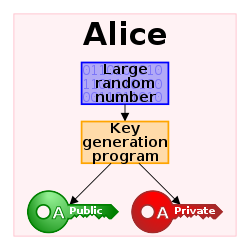A Quantum Attack on Bitcoin: How Soon Before Your Crypto Wallet Is at Risk?

Bitcoin’s trillion-dollar market value rests on math. Its transactions are secured by encryption that, for now, no ordinary computer can crack. But a new computing model, quantum computing, poses a unique challenge. Once scaled, it could break the cryptographic backbone of Bitcoin in a matter of hours, threatening its future as “digital gold.” The risk is not immediate, but the stakes are too high to ignore.
Bitcoin’s BIGGEST Threat: What Quantum Computers Mean For Your Crypto
How Bitcoin Security Works Today
Bitcoin is secured by public-key cryptography. Each wallet has a public address for receiving funds and a private key used to sign transactions. The link between the two is designed to be a one-way function: a public key can be generated from a private key, but reversing the process is practically impossible.

Source: Wikipedia
Bitcoin relies on digital signatures to authorize transactions. It primarily uses the ECDSA algorithm on the secp256k1 curve, which allows a wallet to prove ownership of coins without exposing its private key. For common address types like P2PKH and P2WPKH, the public key remains hidden until you spend the coins. This reduces the time it’s exposed to potential attacks.

Source:Bitcoin developer
Quantum Computing: Why It Matters for Bitcoin
Quantum computers are a new type of machine that use qubits, which can represent multiple states at once. This lets them solve certain math problems far faster than regular computers.
One of the most important breakthroughs is Shor’s algorithm, which could eventually break the cryptographic systems that secure Bitcoin. It threatens elliptic-curve cryptography (ECC), the math behind Bitcoin’s ECDSA and Schnorr signatures.
Current research suggests breaking Bitcoin’s ECC would require thousands of stable logical qubits and trillions of operations, which is well beyond today’s quantum computers. But as pace of advancement in the technology sector continues to increase exponentially, it’s only a matter of time before this becomes feasible.
The Real Threat Level
Today’s most advanced machines, like IBM’s 1,121-qubit Condor and Atom Computing’s 1,200+ qubit processor, are impressive, but these are physical qubits, which are noisy and error-prone.
To break Bitcoin’s security, you would need millions of physical qubits to support the thousands of logical qubits required for cryptographic attacks. Estimates suggest it would take around 13 million physical qubits to forge a Bitcoin signature in 24 hours, far beyond current capabilities.
However, there’s another risk called “harvest now, decrypt later.” Hackers could store transaction data today and then decrypt it once powerful quantum machines are available. This is why agencies are already urging organizations to prepare.
When Could This Become a Problem?
Upgrading global systems takes time, so governments and researchers are acting early:
-
In 2024, new post-quantum cryptography (PQC) standards were finalized to protect against future threats.
-
The UK’s roadmap predicts that quantum computers could start posing serious risks around 2028–2031, with full migration to quantum-safe systems by 2035.
Simplified timeline:
-
2025: 1,000+ physical qubits reached
-
2028–2031: Early migrations begin
-
2035: Quantum-safe cryptography fully adopted
Building Post-Quantum Defenses
The security community is not standing still. The U.S. National Institute of Standards and Technology (NIST) is coordinating a global initiative to establish post-quantum cryptography (PQC) standards. These algorithms are designed to withstand quantum attacks while remaining practical for real-world use.
Meanwhile, blockchain developers are exploring proactive strategies such as:
-
Upgrading wallet addresses to quantum-resistant formats
-
Implementing hybrid or layered cryptography to combine classical and quantum-safe methods
-
Providing pathways for users to migrate assets into quantum-safe wallets before risks materialize
These measures aim to future-proof Bitcoin and other cryptocurrencies, ensuring a smooth transition if quantum capabilities arrive earlier than expected.
What Investors Can Do Now
-
Stay informed: Follow post-quantum cryptography updates and watch for wallets and exchanges to start supporting quantum-safe migration paths.
-
Diversify holdings: Avoid putting all your funds into a single cryptocurrency to reduce risk from unexpected technological changes.
-
Use modern practices: Choose address types like P2WPKH and avoid reusing addresses to limit public key exposure.
Bottom Line
Quantum computers are not yet powerful enough to break Bitcoin’s security, but progress is accelerating. Governments and researchers are preparing now, and Bitcoin has the flexibility to upgrade if the community works together.
This is not an overnight crisis. Instead, it’s a long-term challenge that will unfold over the next decade. By planning ahead, Bitcoin and other systems can transition smoothly to quantum-safe cryptography.
Vous aimerez peut-être aussi

A whale sold over 167,000 HYPE tokens in the past 12 hours in exchange for 9.06 million USDC.

Vitalik Buterin to Deliver Keynote After Shanghai Upgrade at ETHTaipei
